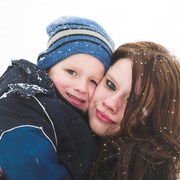 Rohit Seth/PhotoSpin
Rohit Seth/PhotoSpin
What is Frostbite/Frostnip?
Frostbite occurs when ice crystals form in the skin or deep tissue and the skin becomes damaged due to prolonged exposure to cold temperatures, usually below 32F. (1)
The fingers, hands, toes, ears, nose and cheeks are most susceptible to frostbite. Children are particularly at risk because their bodies lose heat faster than adults.
According to Taizoon Baxamusa, MD, spokesperson for the American Academy of Orthopaedic Surgeons, “It takes only minutes for exposed skin to become frostbitten if the temperature fall below 20 degrees Fahrenheit and the wind is blowing at 20 miles per hour or more ... ” (4) In fact, humidity and a windchill factor can make skin freeze even faster. (3)
Frostnip is considered the first stage of frostbite. It irritates the skin but doesn’t result in permanent damage. It can affect the cheeks, ears, nose, fingers and toes. The skin may be red, and the area may feel numb or tingly. (1, 2)
Skin that is frostbitten looks waxy and white, is hard, feels numb and has a “persistent burning sensation. In more severe cases, frostbitten skin will become blue and mottled or splotchy.” (3)
“Severe frostbite can result in blisters or ulcers forming and may involve deeper tissues. As frostbite progresses, tissue death and gangrene may occur.” (1)
How to Treat Frostbite/Frostnip
If frostnip occurs, bring your child inside and warm the skin by using warm compresses or immersing in warm water (100F to 105F) until sensation returns. Avoid rubbing or massaging the skin.
“If symptoms of frostbite occur or warming the skin does not help, call your child’s physician immediately.” (1)
If you think your child has frostbite:
• Remain calm.
• Move your child inside (if your child’s feet are affected, carry him/her in, do not allow him/her to walk).
• Put him/her in dry clothes (wet clothes draw heat away from the body). (5)
• Call your child’s physician or take your child to the emergency room immediately.
• While waiting for medical assistance:
o Give your child something warm to drink and wrap him/her in a blanket.
o Apply warm compresses to the skin by using warm compresses or by immersing the area in warm water (100F to 105F) until sensation returns. If you don’t have a thermometer, dip your elbow in the water. If the water is too hot for your elbow, it’s too hot for the child. (3)
o “Do not rub or massage the skin.”
o “Do not use direct heat such as heating pads or fires.”
o “Do not place the frostbitten skin in snow to ‘warm’ it.”
o “Apply clean cotton or gauze between fingers and toes if they are affected.”
o “Do not disturb any blisters.”
o “Wrap warmed areas of the skin to prevent further damage.” (1)
How to Prevent Frostbite/Frostnip
Aside from the obvious protection of staying indoors if the weather is too cold, it is also imperative that your child is dressed for the weather.
Some schools have a policy of not allowing children outside if the temperature and windchill is below a certain temperature.
The best way to keep warm in cold weather is to dress in layers.
The first layer, the layer next to the skin, should include clothes that will keep moisture away from the skin such as thermal underwear, moisture-reducing winter sportswear, cotton socks and mittens and glove liners. Make sure the clothes aren’t too tight so they don’t impede circulation.
The second layer should include clothing that resists dampness and maintains body temperature such as heavy pants, sweaters and sweatshirts. The third layer is the outerwear and should include moisture-resistant (not moisture-proof) coats and jackets, hats, scarves, gloves and mittens and boots. (3)
Sources:
1) Frostbite. Lucile Packard Children’s Hospital at Stanford. Web. Feb 18, 2013.
http://www.lpch.org/DiseaseHealthInfo/HealthLibrary/poison/frostbit.html
2) Frostbite. MayoClinic. Web. Feb 18, 2013.
http://www.mayoclinic.com/health/frostbite/DS01164
3) Frostbite Prevention. Children’s Hospital of Pittsburgh. Web. Feb 18, 2013.
http://www.chp.edu/CHP/Frostbite+Prevention+for+Parents
4) Tips to Prevent Frostbite During These Sub-Zero Temperatures. American Academy of Orthopaedic Surgeons (AAOS) (2009, January 15). Tips To Prevent Frostbite During These Sub-zero Temperatures. Web. Feb 18, 2013.
http://www.sciencedaily.com/releases/2009/01/090114211625.htm
5) Frostbite. KidsHealth.org. Web. Feb 18, 2013.
http://kidshealth.org/parent/firstaid_safe/emergencies/frostbite.html#
Reviewed February, 19 2013
by Michele Blacksberg RN
Edited by Jody Smith





Add a CommentComments
There are no comments yet. Be the first one and get the conversation started!